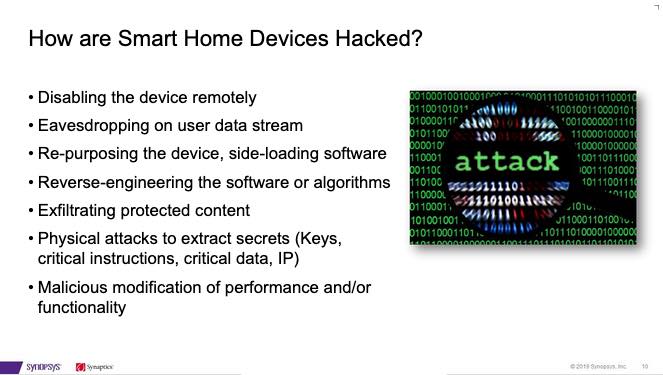Like many people, I have been adding automation to my home, and the number of connected devices I use has slowly but steadily increased. These include light bulbs, cameras, switches, a thermostat, a voice assistant, etc. Between them, they know when I am home or away, and have the ability to record images and sound. In addition to privacy concerns, if they were hacked, they could turn off my security system, hijack my heat or air conditioning, and potentially control home appliances such as ovens and refrigerators. It should be clear that connected home devices can cause real harm if they are compromised. As a consumer I need to trust that the embedded systems in the devices are secure.

What are the best practices for designing home automation hardware so it is secure? According to Synopsys and Synaptics in their recent webinar on “Securing Connected Home Devices Using OTP NVM IP”, it starts with creating a trusted execution environment (TEE). Krishna Balachandran, Product Marketing Manager for NVM IP at Synopsys, and Jingliang Li, ASIC Architect in the IoT Department at Synaptics, describe how one-time programmable (OTP) non-volatile memory (NVM) is an excellent choice for creating the foundation for a TEE.
Indeed, they point out that more is at stake here than just the security of your home. Also, incoming data streams such as copyrighted media also pass through the connected home in the form of music, video, and images. In their webinar they discuss how the starting point for TEE is firmware in ROM and secure keys. With this the firmware can be validated and the keys can be verified. The unique keys are created and then stored in the device using NVM OTP that is programmed when the device is manufactured.
OTP NVM can be programmed at the time of manufacture using an externally provided voltage programming supply or it can optionally be programmed later using the chip’s supply voltage with a built-in charge pump. It is possible to permanently disable programming once the desired contents are written, adding further security.
A big advantage of NVM OTP IP from Synopsys is that they have implemented critical features to ensure security. Krishna talked about how the data is stored in complementary bit cells so that it is not possible to detect data values by monitoring fluctuations in supply voltage. They have also implemented detection for supply voltage tampering, which is sometimes used to compromise on-chip security.
During the webinar Jingliang talked about how Synaptics has used Synopsys NVM OTP IP for many generations of products. Krishna reviewed the process nodes that are supported, and those that are in the qualification process. Even though OTP NVM works on standard CMOS processes using foundry design rules, there is an extensive qualification process, where Synopsys works with the foundry to verify the yield and operation of the OTP NVM.
What was also interesting to learn is that Synopsys OTP NVM IP is useful for more than just key storage. They have several families, each targeted at a specific application. For up to 128Kb, they offer the XBC family. For larger sizes, which would be suitable for code storage, they offer the XHC family for 256Kb up to 1Mb. They have a specialized security-oriented family called XCS. In all they cover 180nm to 7nm, with operating voltages from 1.8V up to those of BCD and HV nodes.
Webinars that include product users are always much more informative. Synaptics has a long and deep history of working in the smart home area. They are the main supplier of Android based TV platforms. They also work with Google on a range of connected home products. So, it is good to hear their perspective on effective methods to add security. If you want to watch the entire webinar replay it is available on the Synopsys website.
Share this post via:





Comments
There are no comments yet.
You must register or log in to view/post comments.